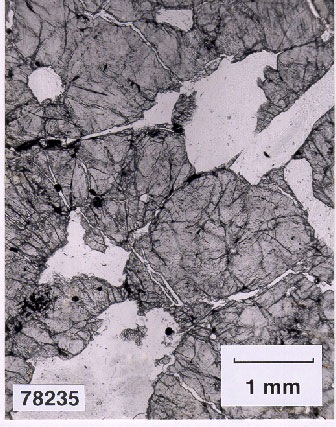
BRIEF DESCRIPTION OF 78235
| Lunar Sample Compendium Link | Lunar Sample Catalog Link | Open University Virtual Microscope Link |
Figure 42. Photo of shocked norite 78235 showing large cracked pyroxenes and maskelynite. The expansion of the diaplectic plagioclase has caused the cracks in the pyroxene.
Lunar sample 78235 is a heavily shocked norite from the lunar highlands. This sample is a coarse-grained (5 mm) plutonic rock composed of about 50 percent plagioclase and 50 percent orthopyroxene with numerous veinlets of brown glass. Despite a high degree of shock, the mineral boundaries of the original cumulate have been well preserved (fig. 42). Lunar sample 78235 has been studied by Steele 1975, Sclar and Bauer 1975, McCallum and Mathez 1975, and Dymek et al. 1975. The composition is given in table 6.
Pyroxene - Orthopyroxene is light brown and shows undulatory extinction and mosaicism. It is highly cracked, because of the expansion of the adjacent plagioclase. There is no pyroxene exsolution. Rare grains of clinopyroxene occur as inclusions in the plagioclase and in the mesostasis. Pyroxene compositions are given in figure 43.
Figure 43. Composition of pyroxenes in 78235. The orthopyroxene host contains exsolved augite indicating slow cooling in a plutonic environment.
Plagioclase - Most of the plagioclase has been shocked to isotropic maskelynite. It is chemically homogeneous at An95. Some plagioclase has partially recrystallized.
Mesostasis - Interstitial areas between the pyroxene and plagioclase crystals have the triangular shape characteristic of cumulate rocks. Accessory minerals in the mesostasis include silica, troilite, Fe-metal, Nbrutile, chromite, whitlockite, and baddeleyite.
Glass - Numerous glass veins penetrate this rock. It has been highly shocked.
Petrogenesis - Lunar sample 78235 is a pristine norite of cumulate origin. The original crystallization age of this norite was about 4300 million years. Several other lunar rocks originated at this time (Table 5). Sample 78235 has been highly shocked, but has retained its original mineralogy and texture. It was chipped off of a small, glass-covered boulder on the surface of the regolith at the Apollo 17 site. The boulder could have been locally derived or it could have been thrown there from a great distance away.


